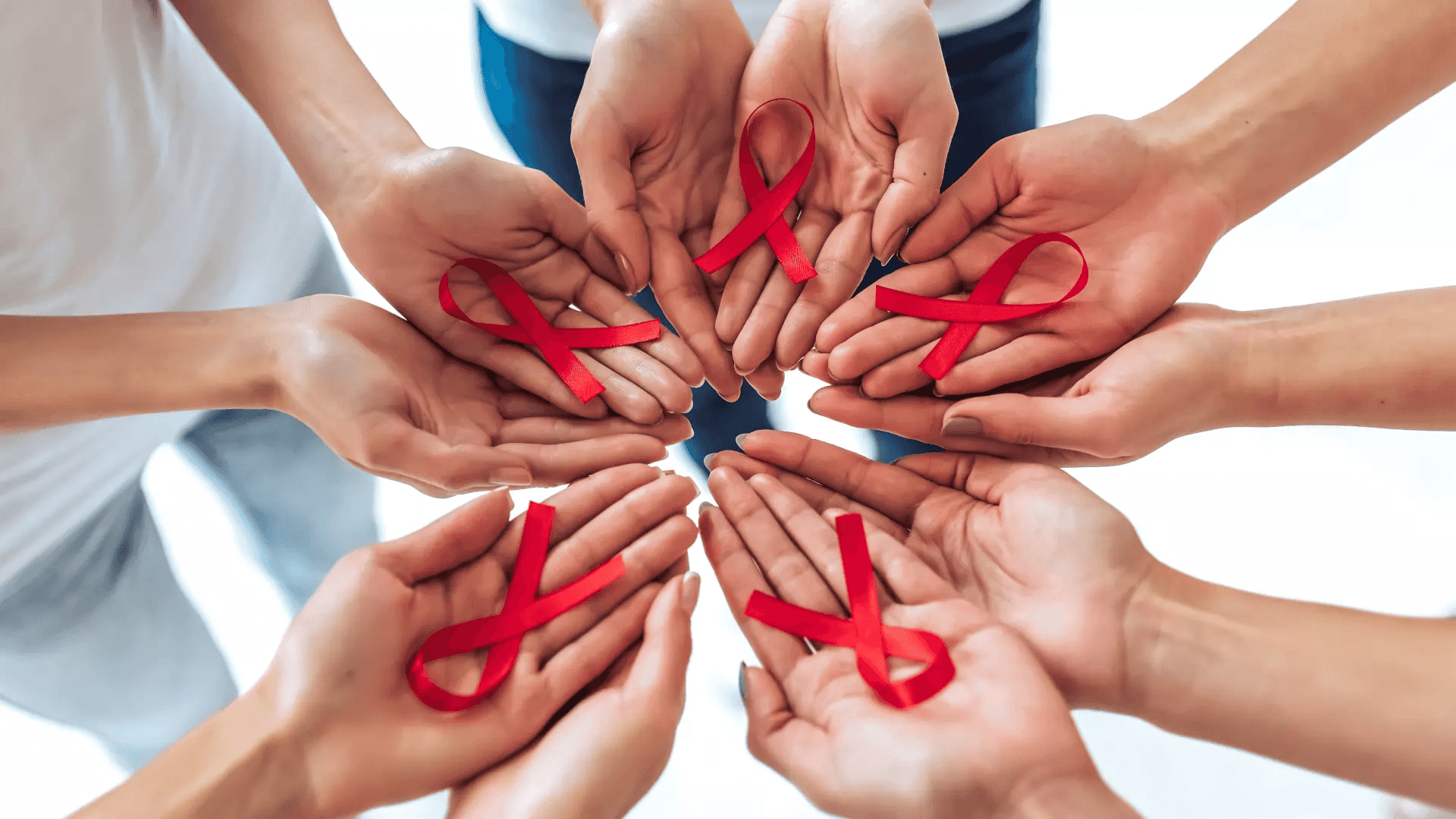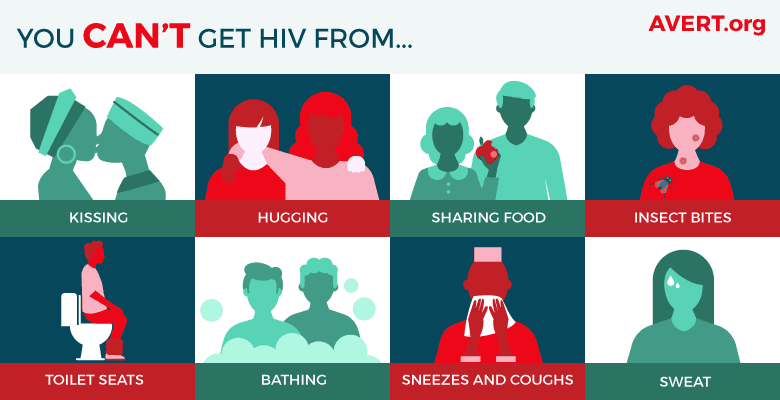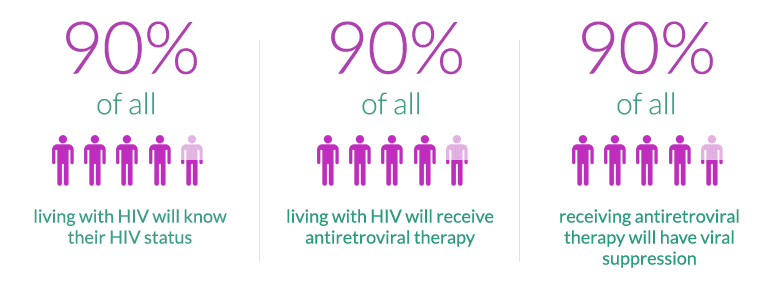
Introduction
Human Immunodeficiency Virus (HIV)
It is a virus that attacks and weakens the immune system, weakening our body’s ability to fight diseases.
Acquired Immune Deficiency Syndrome (AIDS)
When opportunistic infections or cancers take advantage of a very weak immune system, caused by HIV, the person is said to have AIDS.
HIV was first identified in 1980s in America by Robert Galo and Luc Montagnier. It was first detected among the gay men in USA, but now HIV is everywhere around the world and is found in all sections of the population.
HIV can only be passed on from person to person if infected body fluids (such as blood, semen, vaginal or anal secretions and breast milk) get into your bloodstream in these ways:
- Unprotected sex
- From mother to child during pregnancy, childbirth or breastfeeding
- Injecting drugs with a needle that has infected blood in it
- Infected blood donations or organ transplants.
Facts & Myths
- HIV does not show any obvious symptoms at the onset. However, a person with HIV can transfer the virus to another
- A person may not have any signs of HIV/AIDS for as long as 10 years and may still pass on the virus to another, especially if they do not take proper medication.
- If immediate medical action is not taken, a person risks losing their lives eventually, as the virus progresses.

Illustration from avert.org
A video on the science of HIV
- One of the most common myths people living with HIV hear is that they can be cured. There’s no cure yet for HIV, but antiretroviral treatment works and will keep someone living with HIV healthy.
- HIV can’t survive outside of the body so you won’t get HIV from touching someone, hugging them or shaking their hand.
- There is no HIV in an infected person’s sweat, tears, urine or faeces.
- You cannot get HIV from insects. When an insect (such as a mosquito) bites you it sucks your blood – it does not inject the blood of the last person it bit.
- HIV stands for Human Immunodeficiency Virus, which means that the infection can only be passed on between humans and not through animals.
- HIV cannot survive in the air so coughing, sneezing or spitting cannot transmit HIV.
- New needles cannot transmit HIV because they haven’t been in the body of an infected person. If used needles are cleaned and sterilized properly they can’t transmit HIV either.
- HIV can’t survive in water, so you won’t get HIV from swimming pools, baths, shower areas, washing clothes or from drinking water.
- HIV can’t be passed on through food or cooking utensils even if the person preparing your food is living with HIV.
- Toilet seats, tables, and door handles, cutlery, sharing towels: HIV doesn’t survive on surfaces, so you can’t get HIV from any of these.
- Used condoms: HIV can only survive for a really short amount of time outside of the body. Even if the condom had sperm from an HIV-positive person in it, the HIV would be dead.
- There is such a small amount of HIV in the saliva of a person living with HIV that the infection can’t be passed on from kissing.
- Tattoos and piercings: There is only a risk if the needle used by the professional has been used in the body of an HIV-infected person and not sterilized afterwards. However, practitioners are required to use new needles for each new client.
Steps To Prevention
- End the silence, stigma and shame.
- Provide youth-friendly health services: welcoming, confidential, conveniently located and affordable.
- Engage young people who are living with HIV/AIDS: They more than anyone else can convey the message that individuals must make every effort to ensure that no one else contracts HIV from them.
- Reach out to young people most at risk.
- To reduce your risk of HIV infection, use condoms correctly every time you have sex.
- Don’t inject drugs. If you do, use only sterile injection equipment and water and never share your equipment with others.
- Insist that your partners get tested and treated too. Having an STD can increase your risk of becoming infected with HIV or spreading it to others.
Girls are more vulnerable than boys because:
- Cultural norms related to sexuality prevent many girls from taking active steps to protect themselves.
- Sexual mixing: Older men having sex with young girls.
- Some girls protect their virginity by engaging in anal intercourse
- Sexual abuse: Rape, sex work.
Marriage provides no protection to young women if husband much older:
- A study in Pune STI clinic reports 25% of the women infected with STIs and 14% with HIV. 93% of these women were married and 91% had never had sex with anyone but their husbands.
- In another study in Kenya, no women were found infected whose husbands were only three years older or less.
- Lacking the power to negotiate safe sex practices, many young brides may be even more vulnerable to HIV/AIDS and STIs than unmarried girls.
Some young people at especially high risk:
- Young people who inject drugs.
- Adolescents who are sexually violated Abusers are unlikely to use condom and the cuts and tears that result from forced sex increase the likelihood of HIV infection.
- Young people in sex trade: It is estimated about 1 million children world over are abducted or coerced into the sex trade every year; The Social Welfare Board of India reports roughly 40% sex workers are children under 18.Clients often target young adolescents because they believe children do not carry HIV.
- Young males having sex with males: Besides the biological easier passage of HIV through anal lining, the social stigma and violence on those identified as homosexuals can magnify the risk of contracting HIV – they may hide their sexuality and consequently do not have access to the information they need.
- Children orphaned or affected by AIDS: Over 13m children under 15 have lost one or both parents to AIDS.
STI and STD
Any infection transmitted through sexual contact is called STI. It is generally transmitted through sex but may also have other routes of transmission.
STI talks of infection which may or may not lead to the occurrence of disease which is called STD.
Urgency to deal with STI, with emergence of HIV epidemic:
- Preventing STI prevents HIV.
- Treating STI in presence of HIV, can reduce the rate of transmission of HIV.
- Treating STI in presence of HIV, contributes in lowering the rate of HIV progression.
- Improvement in the management of STIs can reduce the incidence of HIV infection in the general population by about 40%.
Testing for HIV/AIDS
Keep calm and get tested (KCGT) a campaign that encourages the youth to get tested for HIV. The idea of the campaign is to fight against the stereotype ‘it doesn’t concern me’ and to show that getting tested is something obvious”. The motive is to spread that “if One’s safe, all safe”.
A video on how people reacted when they were asked about getting tested for HIV
So why get tested?
- Mind at rest
- Right choices for your health
- Protects your loved ones
- Bust the Myth and Stigma
- Provides accurate statistics
- Do your part in preventing the disease. It is the only sure way of knowing your status.
It is Safe, Easy, Confidential and Free
Global Goals

Illustration from avert.org
While AIDS remains incurable, patients are living much longer – even decades after infection – because of the development of many effective medications to suppress the virus. The most effective type are known as antiretroviral drugs, which are often taken in combination to prevent the patient from becoming resistant to any one drug.
According to the National Institutes of Health, the most common antiretroviral drugs fall into three categories:
- Reverse transcriptase inhibitors, which keep the virus from reproducing
- Protease inhibitors, which interfere with an HIV protein that produces infectious particles
- Fusion inhibitors, which prevent the virus from entering healthy cells
Doctors verify if medications are working through blood tests, which measure levels of various infection-fighting blood cells as well as the level of HIV in the blood. Even when the virus is undetectable, AIDS is not cured and can still be transmitted to others.
Other HIV/AIDS treatment focuses around living a healthy lifestyle with optimum nutrition, sleep and exercise. Regular doctor’s visits are also scheduled, with frequency depending on viral levels in the blood and what symptoms are present.
Safe spaces
Since many years we have been witnessing that, the HIV infected people are discriminated from the society on many grounds. People think that if they stay in contact with the infected person that might also get the infection. HIV infected people are discriminated at their workplaces, they are kept away from the social gatherings, their friends refuse to show up, their family members sometimes neglect their responsibilities to support them.
For people infected with HIV safe spaces plays a very vital role in giving them courage to fight with their circumstances. Being a HIV patient people face discrimination, a safe space for them will create an environment where they will feel involved. Such an environment will help them to improve the self esteem and also give mental peace to the patients.
Life is like unto a long journey with a heavy burden. Creating a safe space for everyone is like sharing their burden of life and making everyone’s life a little easier to live with respect and dignity.
Activity 1: Two Truths and a Lie
In this activity each participant in the group says three things about HIV — two truthful things and one lie. The other participants can guess which one is the lie and give a reason why think so. If the group is large you divide them into smaller groups. Make sure that all the correct facts are known to everyone in the group at the end of this activity.
Activity 2: Shaking hands
Materials required:
- Paper slips
- A bowl
- Hand out slips of paper to everyone in the room. They are to keep these slips of paper concealed to themselves. Most of the papers will have ‘O’ on them and have a few with ‘X’ on it. The ‘O’ represents HIV- people, and the X represents HIV+. Again, everyone keeps it to themselves so no one knows who has an X or O.
- Then, ask everyone to get up and walk around the room and shake hands with other people – as many as they want to. They should keep track of who they shook hands with. At the end of the game, the people who have an X reveal who they are, and everyone who shook their hands (which would represent unsafe sex) would realize that they would have caught HIV from this totally unsuspecting person.
- This will reinforce the idea that we can never be sure of our status unless we get tested and to remove the idea of stigma attached to getting tested.
- Note: Do inform the participants that HIV does not spread through shaking hands.